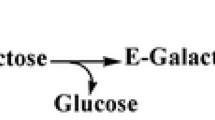Abstract
Although gliadins are known to induce coeliac disease, the toxicity of single gliadin components is still uncertain. Therefore, the main components of ω-, α- and γ-type gliadins from the wheat cultivar Rektor were preparatively separated by RP-HPLC. Purity and type of the isolated components (one ω-, eight α- and four γ-gliadins) were confirmed by N-terminal amino acid sequencing. Gliadin components were digested with immobilised pepsin and trypsin and 0.5 mg of dialysed hydrolysates was tested with a foetal chick intestine assay which has been proven to be specific for the coeliac toxic effect of total gliadin and enzymatic hydrolysates. The reduction in sucrase activity was compared with a control culture and was taken as an indicator for toxicity. The results demonstrated that all the gliadin components studied remarkably reduced the increase in sucrase activity to 23–68% of the control assays. Important differences in the inhibitory action between the three gliadin types could not be detected, and only in a few cases did the single components differ significantly. Based on these results, it seems impossible to remove the toxic factor of gliadins by plant breeding.
Similar content being viewed by others
Author information
Authors and Affiliations
Additional information
Received: 24 April 1999
Rights and permissions
About this article
Cite this article
Mothes, T., Osman, A., Seilmeier, W. et al. The activity of single gliadin components in a foetal chick intestine assay for coeliac disease. Eur Food Res Technol 210, 93–96 (1999). https://doi.org/10.1007/s002170050541
Issue Date:
DOI: https://doi.org/10.1007/s002170050541




